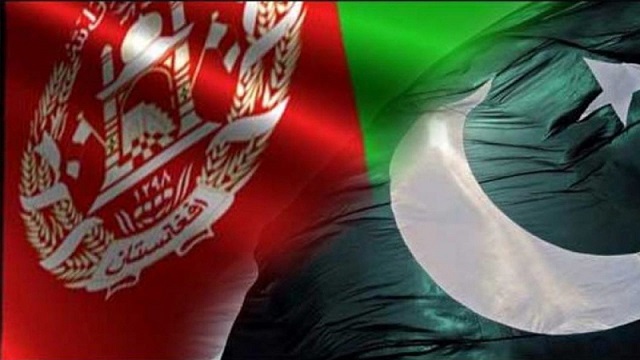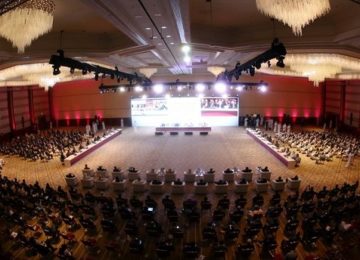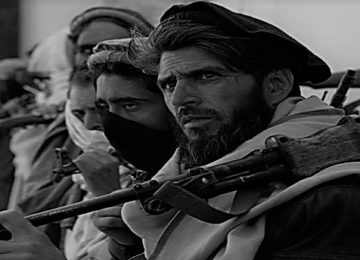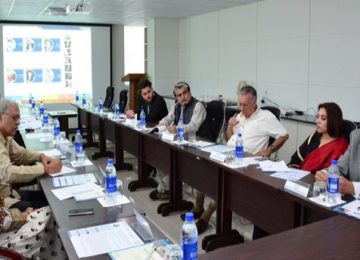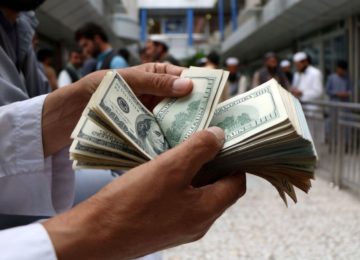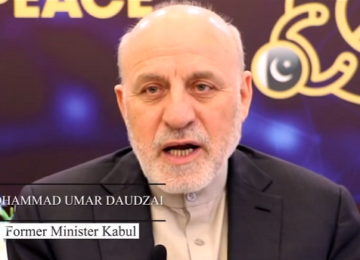May 26, 2021
As U.S. troops begin what may be their final withdrawal from Afghanistan, no third country will be affected by their departure as much as Pakistan, which shares a long, porous border with Afghanistan, hosts much of the Taliban leadership as well as millions of Afghan refugees, and faces threats from Pakistani militants based there.
For Pakistan, America has been both a partner and a strategic competitor in Afghanistan. Notionally, the U.S. exit presents Islamabad with an opportunity to proactively shape Kabul’s political future in its favor. But in reality, a post-withdrawal Afghanistan without an internationally backed, intra-Afghan accord offers far greater risks than rewards for Pakistan. An emboldened Taliban and a potential civil war next-door would not only jeopardize Islamabad’s dreams for regional connectivity, but also pose a threat to its own domestic security.
Managing the Superpower next door for nearly two decades, the U.S. presence in Afghanistan across Pakistan’s northwestern border has been a problem for Islamabad—one it has sought and struggled to manage.
After the 9/11 terrorist attacks, then-U.S. Secretary of State Colin Powell called up the Pakistani president at the time, Pervez Musharraf, and gave him an ultimatum, saying, “You are either with us or against us.” Later, Powell’s deputy, Richard Armitage, reportedly warned Pakistan that if it chose to support the terrorists, it “should be prepared to be bombed back to the Stone Age.” In response, Pakistan partnered with America against al-Qaida and instantly found itself a frontline state in the so-called “war on terror,” while also reluctantly aiding the ouster of the Afghan Taliban regime, which it had supported as a proxy for its interests there since the mid-1990s.
In the days and weeks after 9/11, senior Pakistani officials counseled their American counterparts that the total elimination of Taliban rule would allow warlords—who had controlled and fought over Afghanistan in the 1990s—to return to power, and could even ignite an insurgency. As journalist Steve Coll reports in his book “Directorate S,” the then-head of Pakistan’s Inter-Services Intelligence, Lt. Gen. Mahmud Ahmed, advised a U.S. military official at the time to “give engagement with the Taliban a chance” and warned that the impending invasion “will be an incubator of anger that will explode two or three years from now.”
His words were prescient. With the American invasion, the government of the Afghan Taliban, which had ruled Afghanistan since the mid-1990s, was ousted from power by forces from the Northern Alliance, a military coalition of mujahideen fighters supported by India, Iran, Russia and, after 9/11, the United States. The Afghan Taliban appeared to be vanquished. In the initial years after the invasion, as a group and as individuals, they sought to surrender to the new government. Many offers of capitulation, including from Taliban founder Mullah Omar, were rebuffed or vetoed by the Bush administration.
Pakistan’s military leadership not only distrusted America—a feeling that, of course, was mutual—but it also lacked confidence in the new order the U.S. had established in Afghanistan. But at the same time, the new regime in Kabul, backed by the U.S. military, was sowing the seeds for the next phase of the conflict, as Afghan national security forces dominated by warlords and members of ethnic minorities took control of southern Afghanistan, the Taliban heartland, fostering resentment among the local population. By 2006, fueled by these grievances, the Afghan Taliban had regrouped and assumed the role of a full-fledged insurgency.
For its part, Pakistan hedged. It provided a vital supply route for the U.S.-led mission in Afghanistan, as well as airbases and intelligence, and in 2002, the Pakistan army took the rare step of deploying forces to the tribal areas in northwest Pakistan to help the U.S. mission combat al-Qaida militants who had settled there after fleeing capture in Afghanistan.
Yet Pakistan never quite trusted the American presence, which brought to power what it viewed as a hostile government in Kabul. A pervasive view in Pakistan’s strategic community, including among senior military officials, was that America aimed to use its presence in Afghanistan to denuclearize Pakistan. These fears were compounded by frequent U.S. reporting, citing unnamed American intelligence officials, about teams of special operations forces tasked to seize Pakistani nukes. Indeed, when then-Pakistani army chief Gen. Ashfaq Kayani first learned that a helicopter had crashed in Abbottabad on the night that the U.S. killed Osama Bin Laden, his immediate assumption was that the crash was part of an operation targeting Pakistan’s nuclear assets.
Pakistan’s military leadership not only distrusted America—a feeling that, of course, was mutual—but it also lacked confidence in the new order the U.S. had established in Afghanistan. What’s more, Pakistan bet that the American presence would not be permanent and that the Afghan Taliban’s influence would endure and outlast it.
This was no agnostic bet. The Afghan Taliban leadership was now firmly ensconced in refugee and kinship enclaves in northwestern Pakistan. And they were at times aided in the insurgency they waged against the U.S.-backed Afghan government by elements of Pakistan’s military-intelligence community.
The Problem of Talibanism Pakistan’s wager that the Taliban would have greater staying power than the United States proved to be correct. The Taliban, after all, were the home team: As individuals, they were sons of the soil, and as a group, they were rooted in the tribal structure in southern Afghanistan. But what Pakistan did not foresee was that the phenomenon of Talibanism would become a double-edged sword—and the effects of that oversight were catastrophic.
In the first few years after 9/11, Pakistan was punished by local and international jihadists for its support of the U.S.-led war on terror. Beginning in 2003, then-President Musharraf was targeted in a series of assassination attempts by jihadists formerly linked to Pakistani intelligence who had subsequently defected into al-Qaida’s orbit. And in the wake of the Pakistan army’s reentry into the Pashtun tribal areas, local militants allied with al-Qaida began to form their own insurgency. First among the militant godfathers that led their emergence was Nek Muhammad, a Wazir tribesman who delivered the Pakistan army its first humiliating defeats in South Waziristan, one of the tribal districts. Then came Abdullah Mahsud, an ex-Gitmo detainee who released gory videos of Pakistani soldiers being executed by children.
Inspired by the Afghan Taliban’s pre-9/11 Islamic emirate, these Pakistani militants sought to implement a similar system in their own country—by force. Finally, in 2007, Pakistani Taliban franchises united under an umbrella organization known as Tehreek-e Taliban Pakistan, or TTP, led by a militant leader from Waziristan, Baitullah Mehsud. Together, they ravaged Pakistan over the next seven-plus years, taking the lives of tens of thousands of civilians, killing hundreds of Pakistani soldiers and even assassinating senior politicians, including former Prime Minister Benazir Bhutto.
When the Pakistan army launched its first methodical counterinsurgency operations in Swat—another region in the Pashtun tribal areas—and South Waziristan in 2009, the TTP began to flee into Afghanistan. Once there, some TTP affiliates were co-opted by Afghan intelligence and others continued to supply fighters to the Afghan Taliban. With the last of the Pakistan army’s major operations in the tribal belt—Operation Zarb-e-Azb, in 2014—the TTP ceased to control significant territory in Pakistan and further splintered into competing groups In the intervening years, relentless raids across the country, including joint operations by the Inter-Services Intelligence and police in urban areas, have vastly reduced the TTP’s ability to strike the major eastern population centers. But even as it weakened, the network has continued to wage a low-intensity conflict in Pakistan.
After the American Departure, Whither the TTP?
In the past year, the TTP’s competing factions have taken steps to reunite. The deadly April 21 attack on a highly secure Pakistani hotel in the city of Quetta, claimed by the TTP, was part of an attempt by the group to signal its return. Though the TTP’s involvement hasn’t been independently confirmed, the attack portends a renewed capability to conduct high-profile operations.
Still, it is still uncertain how the TTP—and, in turn, Pakistan—would be affected if, after the U.S. withdrawal, the Afghan Taliban once again dominates Afghanistan. While the Afghan Taliban continues to be portrayed as a proxy for the Pakistani government, in truth, their relationship today—and the relationship between the TTP and the Afghan Taliban—is much more complicated. Over the years, there have been several localized clashes between the Afghan Taliban and TTP elements. But some elements of the TTP have partnered with and fought alongside the Afghan Taliban, and Afghan Taliban commanders have been known to mediate disputes between TTP factions. One TTP propaganda video even showed the group’s second emir, Hakimullah Mehsud, fraternizing with top figures from a Taliban offshoot known as the Haqqani Network.
Inspired by the Afghan Taliban’s pre-9/11 Islamic emirate, these Pakistani militants sought to implement a similar system in their own country—by force. Most importantly, the Afghan Taliban have rarely—if ever—used their coercive capabilities to restrain the TTP from attacking Pakistani security forces, nor did they ever outright condemn the TTP as it ravaged Pakistani cities with terrorist attacks. If the U.S. exits Afghanistan without an intra-Afghan accord in place, and an emboldened Afghan Taliban pursues total victory, they might turn to TTP fighters for support against the current Afghan government. That would temporarily redirect the TTP from targeting Pakistan, so the Pakistani government may, for a time, benefit. But if the Afghan Taliban reestablish their emirate, even if it is short-lived, their success could embolden jihadists who seek to do the same in Pakistan.
So as much as the departure of American forces from Afghanistan may please Pakistan’s strategic planners, the potential return of Taliban rule in Afghanistan presents a longer-term dilemma. The failure to secure an interim government arrangement or a broad-based, intra-Afghan political settlement prior to the departure of American troops would leave the Afghan Taliban too powerful, while further weakening Pakistan’s ability to control the group.
There are indications that in the past decade, Pakistan has sought a post-American political setup in Afghanistan that would integrate the Afghan Taliban as a constituent element of the new government, but not an absolutely dominant one. For example, in 2010, recognizing already that the U.S. sought an exit from Afghanistan, Gen. Kayani appeared to be trying to increase Pakistan’s influence in Afghanistan’s power structure—and not simply through Taliban control. He told foreign reporters that he did not seek a Talibanized Afghanistan, offered to train the Afghan National Army and expressed a clear desire for a central role for Pakistan in the Afghan peace process.
In the past year, that has become even clearer: Pakistan has cosigned joint statements calling for the preservation of post-9/11 “gains” in Afghanistan and opposing the reestablishment of the Taliban’s emirate. And last week, after an important visit by the Pakistani army chief to Kabul, Afghan President Ashraf Ghani claimed that the Pakistani army had “announced that the revival of Islamic Emirate is not in Pakistan’s national interest.” Ghani has a tendency to overstate the commitments foreign powers make to Afghanistan, but his claims are consistent with public statements made by Pakistani officials.
Averting an Afghan Civil War
The ideal scenario for Pakistan is the integration of the Afghan Taliban into a hybrid political setup that falls short of being a declared Islamic emirate and is inclusive enough to remain stable and gain international legitimacy. But the Afghan peace process has stalled. The Afghan Taliban have resisted Pakistani pressure to attend talks that had been slated to take place in Istanbul. It is possible that these talks could resume after the withdrawal of U.S. and coalition forces or if the Afghan government agrees to release additional imprisoned Taliban fighters. But the Afghan Taliban would come to these renewed talks with greater leverage than ever before, making them less likely to concede on the type of political system they are demanding, which could lead to deadlock and continued fighting.
Unfortunately, the long-term scenario in which the Afghan Taliban consolidate their control over southern Afghanistan and strengthen their grip over other parts of the country is a real possibility. They are unlikely to be able to maintain nationwide dominance for very long, but in the meantime, the attrition of Afghan national security forces would probably intensify—splintering is even a possibility—as the government responds to Taliban offensives with even more destructive force. A brutal civil war would likely ensue, sending refugees into Pakistan once again.
In recent years, Pakistan has managed to insulate itself from events in Afghanistan to a considerable degree, spending hundreds of millions of dollars on fencing their shared border. The effects of these efforts, alongside large-scale military operations, are clear: As violence has surged in Afghanistan, terrorism in Pakistan has receded to levels not seen since the early years after 9/11.
But managing both population inflows as well as the loyalties of groups on the ground would be difficult with a civil war next door. Al-Qaida and perhaps even the local affiliate of the so-called Islamic State would thrive in such a chaotic environment. And should these terror groups regenerate their ability to carry out operations beyond Afghanistan and conduct an attack on American interests or soil, Washington may hold Islamabad accountable.
So as much as the departure of American forces from Afghanistan may please Pakistan’s strategic planners, the potential return of Taliban rule in Afghanistan presents a longer-term dilemma. For these reasons, an all-out Afghan civil war would force Pakistan to devote greater resources to its northwest. That could in turn make it more vulnerable along its eastern border, where relations with India remain tense despite recent diplomatic efforts toward a thaw. An Afghan civil war would also undoubtedly serve as a barrier to Pakistan’s long-standing dream of strengthening its economic and diplomatic ties to Central Asia via Afghanistan.
At the same time, Pakistan’s leverage over the Taliban has diminished, as its leaders return back home from Pakistan, and as the group builds ties to multiple regional governments—including Iran and Russia. Now more than ever, Pakistan needs to coordinate with the United States, as well as regional powers like China, Iran and Russia, to keep the Afghan peace process alive and press the various Afghan factions to return to the bargaining table. Islamabad should also use the next few months to build networks within the existing Afghan state and among pro-republic factions to balance out the Taliban—similar to what Gen. Kayani seems to have attempted in 2010.
To counter the threats from both al-Qaida and ISIS, Islamabad and Washington should renew intelligence-sharing and other counterterrorism cooperation, and perhaps even multilateralize such an arrangement to include the current Afghan government. As Washington seeks local venues for hosting drones and other aerial assets, some in Pakistan may view this as a basis to build a post-withdrawal partnership with the United States. But the politics of hosting American drones would be ugly, resulting in a domestic backlash that would outweigh the diplomatic benefits.
Finally, there remains the question of what to do with the 6,000 or so TTP fighters based in Afghanistan. There are reports that the Pakistani government reached out to the TTP through the Haqqani Network on a potential peace deal, offering to withdraw the Pakistan army from parts of the tribal areas bordering Afghanistan and allow TTP elements to operate their own “Islamic” system there.
The talks eventually broke down, but if those reports were indeed true, it would seem that the Pakistani state is interested in using jihadist elements to tamp down a recent surge of Pashtun nationalism along its border with Afghanistan. That would amount to repeating the mistakes of the past: a Faustian bargain that yields short-term relief while breathing life into the anti-state phenomenon of Talibanism, enabling the TTP to reconstitute in Pakistan and push deeper into the tribal areas.
Arif Rafiq is president of Vizier Consulting, LLC, a political risk advisory company focusing on the Middle East and South Asia.



